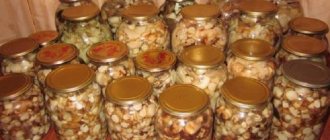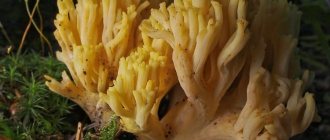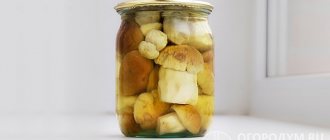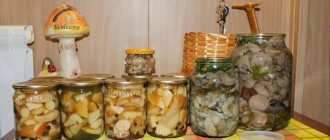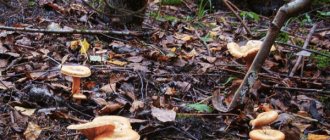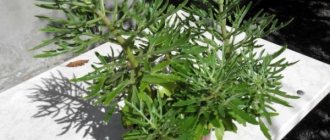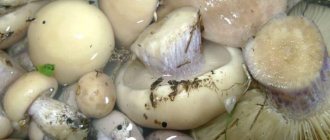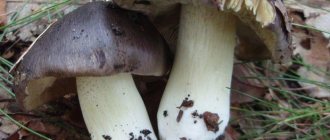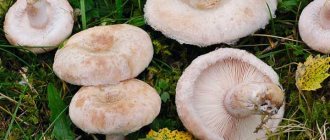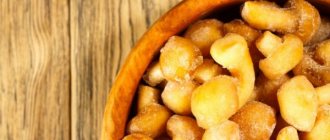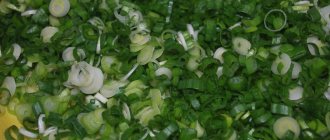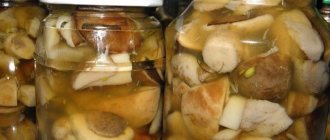We wash the deer horns well to remove forest dirt.
Next, boil the mushrooms in salted water for at least 30 minutes. If necessary, remove the foam.
After cooking, the size of the mushrooms will decrease significantly. There is no need to chop the mushrooms, but you can divide them into inflorescences like cauliflower.
Cut the onion and garlic into small cubes.
We also cut the bell pepper into small cubes.
Melt the butter.
First, fry the deer horns for 3 minutes.
Then add the onion and cook for another 5 minutes.
Then add pepper and cook for another 7 minutes. Then add sour cream and cook for another 5 minutes, don’t forget to add salt and pepper to taste.
Mushrooms and reindeer horns in sour cream are ready, serve hot. It doesn't taste like mushrooms at all.
The forests of Russia are full of bizarre macromycetes. Due to its unusual appearance - resemblance to deer antlers - the mushroom of the department of higher fungi of Basidiomycetes received its name deer horns. There are several other names for this fruit - horned grass, coral hedgehog, coral, etc.
Having encountered a horned mushroom in the forest, not every mushroom picker will dare to cut it off. This is due to its rather exotic appearance. This species is considered edible, and therefore, before being listed in the Red Book, it could be collected and prepared in a wide variety of ways.
Characteristic features of the variety
The botanical name of the coral is Ramaria yellow, which belongs to the family Rogataceae. The shape of the cattail resembles the branched antlers of a deer or underwater coral.
Description of deer horns and photo of the mushroom
The photo clearly shows that the ground part of the deer horn mushroom is very branched.
Its color depends on several factors:
- habitats;
- climate features;
- age.
The branches can be beige, light brown, light yellow, orange or purple. Basically, the height of the fruiting body does not exceed 7 cm, but the width varies from 15 to 30 cm. When pressing on the fruit, a light brown tint appears. When cut, the hornet has a marble-yellow color. The mushroom has a pleasant aroma that resembles the smell of freshly cut grass.
Morphology
The tops of old cattails accumulate substances that give it a bitter taste. Therefore, the upper branches are not used for food. The mushroom itself differs in taste from its relatives, because it does not have a pronounced mushroom taste. Raw cattails are quite elastic, but after cooking they become somewhat harsh.
The hedgehogs are very similar to the golden-yellow ramaria. The differences between these specimens can only be seen under a microscope. Nothing bad would happen if you cut the double, because both ramaria are edible.
Place of distribution
This species is extremely rare. You can find such a treasure in the regions of the Far East, Karelia, the Caucasus, Western and Eastern Siberia, as well as in the Crimea. Most residents of the central part of our country are not even aware of the existence of such “forest bread”.
This is due to the characteristics of the growth of horned ones. They live in damp and shaded places. Most often you can find them in pine or deciduous forests, where the most valuable specimens grow.
Edible or inedible
Hornworts are both edible and inedible. In this regard, you should carefully study the yellow ramaria so that you can distinguish it from other relatives. All hedgehog lookalikes are moderately poisonous or conditionally edible, so eating them cannot be fatal.
Ramaria yellow is an edible mushroom, but it is important to follow some precautions before consuming it. For preparation, only the base is used, because the twigs have a bitter taste. Overripe fruits are considered unsuitable due to the large accumulation of bitterness.
Botanical description
Staghorn mushrooms resemble coral branches or deer antlers in appearance. The photo shows a clear resemblance. The aboveground part of the plant is very branched and decorative. The spines are snow-white, 10 to 20 mm high. The body diameter of the mushroom is 16-30 cm; specimens weighing up to 1 kg are found in nature. It is worth noting that most often the height and width of the exotic mushroom are the same. The branches of the plant are thin and quite brittle. The coral hedgehog only affects the wireworm; other worms are indifferent to it.
Read also: How to cover a young thuja for the winter
The color of the mushroom changes as it grows, acquiring characteristic yellow shades. Obsolete copies may be bright orange. Horntails and amethyst colors grow. The active growing season of basidiomycetes falls from June to October. The biological culture does not have the usual mushroom aroma; in its raw form, the deer horn mushroom has an elastic consistency; when cooked, the fruiting body becomes harsh.
The most commonly mentioned mushrooms can be seen on tree trunks and stumps. Like other woody lower plants, they are not difficult to notice on rotten wood of any species. It is believed that among a certain variety of coral-shaped mushrooms there are no poisonous ones, while there are plants that are conditionally inedible and suitable for consumption. It is better to use young species of deer antlers for food. Large hedgehogs can disappoint with their taste: they are bitter and have an unpleasant aftertaste.
The best collection period is August and September; in the southern regions of our country, slingshots are also collected in winter. They often grow in whole clusters; collecting such mushrooms is an endless pleasure. Knowing the description of edible cattails, you can easily prepare the required amount of forest product and prepare wonderful dishes.
When and how to collect?
When collecting, you should be extremely careful, because among the horned ones there are many poisonous look-alikes. Edible corals are collected and prepared from August to September inclusive. During this period, they can be found in the undergrowth in single “bushes” or groups of several hornets. And in the southern part of the country they are collected even in winter.
Delicious recipe! Pollock fish in sour cream in a frying pan
There are several rules that should be followed when collecting yellow ramaria:
- Old mushrooms should not be cut off, because they have a bitter taste. Only young cattails are collected.
Security measures
You should know that there are quite a large number of mushrooms that resemble deer horns in appearance. Many of them are inedible or even poisonous. Therefore, beginners need to start collecting them under the guidance of experienced mushroom pickers.
They should also be washed and processed well, especially those that are stored for future use, because even edible mushrooms can pose a serious danger if improperly prepared and stored. In addition, you should not collect them along roads and in other polluted places where they accumulate large amounts of toxic substances.
Among the cattails there are lookalikes, some of which are poisonous. A person who does not have much experience may make a mistake and confuse edible and inedible specimens. And therefore you should be careful or ask experienced mushroom pickers for advice.
Anyone who does not like to go into the forest to buy mushrooms can buy them, but you should know that coral mushrooms are a rather rare commodity. They are usually sold in dried form. Prices range from 850 to 1500 rubles per kilogram.
How to distinguish from false, poisonous mushrooms?
It is important to remember that horned mushrooms have quite a lot of doubles, which are inedible or even poisonous representatives of the mushroom world. The first thing you need to pay attention to when collecting is the color of the bush. When young, the mushrooms are milky, beige or yellow.
Old specimens, which are considered inedible due to bitterness, have a bright orange color. The cut site becomes a marble-yellow hue, and when pressure is applied to the fruiting body, a light brown tint is formed. The smell of the mushroom is very similar to the aroma of cut grass.
Ramaria beautiful is a close relative of Ramaria yellow, so they are quite similar. Unlike its edible relative, beautiful ramaria is a poisonous mushroom. It is quite difficult to distinguish them, especially for novice mushroom pickers. Sometimes, when you press on the poisonous fruiting bodies, a red tint appears on the pulp.
Useful properties, restrictions and recipes
In addition to its excellent taste, horned grass has some beneficial properties. It contains amino acids, sterol, lipids and phytoagglutinin. The mushroom is especially popular in Chinese medicine, where it is used to treat gastrointestinal disorders and respiratory diseases. Eating hornets can strengthen the immune system.
There is an opinion that this species has an antitumor effect. Young specimens are also used in cosmetology, because its cells can slow down the aging process.
Yellow corals should be eaten in small portions. There are no special restrictions, except for individual allergic reactions. After collecting, you should wash the slingshots thoroughly, because a lot of debris collects between the branches.
Like other relatives, cattails require cooking for about 30 minutes. They are pre-washed and cut into small pieces. You can use them to make sauces, salads, fillings for baked goods and marinated for the winter.
Ingredients for salad
To prepare a delicious salad, you should prepare the following ingredients:
- 150 g boiled cattails;
- 150 g fresh carrots;
- one medium onion;
- 2 tbsp. l. table vinegar;
- 1 tbsp. l. vegetable oil;
- two cloves of garlic;
- spices and herbs to taste.
Mushrooms are mixed with carrots and finely chopped garlic. After this, season with sunflower oil, add salt and spices. The resulting mixture is mixed well and left for 30 minutes. At this time, you can prepare the onions. It is cut into thin rings and marinated in vinegar. All ingredients are mixed and the salad is left to brew for several hours.
Reindeer horn salad
The soup turns out very tasty. For cooking you will need the following products:
- potato;
- carrot;
- onion;
- butter;
- garlic clove;
- herbs and spices to taste;
- 300-400 g of mushrooms.
The horns are boiled in a separate bowl for 20 minutes, then drained into a colander to drain well. Next, start preparing the soup. Potatoes, carrots, onions and garlic are added to cold water. After boiling, pour the boiled mushrooms into the pan and simmer over low heat for about 10 minutes. Then salt, spices and herbs are added. This makes a light and delicious mushroom soup.
Cooking methods
The description of the mushrooms says that these plants are used in folk medicine, with their help they treat joints, expel worms, etc. It must be remembered that poisoning often occurs due to negligence or complete illiteracy. You should not eat foods that you have doubts about.
There is a separate opinion that convinces mushroom pickers that this type of plant is not suitable for classical preparation. Experts fundamentally disagree with this statement.
Edible hornets are prepared for future use, fried, added to soups, dried, and mushroom caviar and other dishes are prepared from them. Without any doubt, all existing recipes for forest “brothers” are also suitable for corals. In winter, the dry prepared semi-finished product is soaked in water, then fried in batter. Many exotic lovers use these specimens as a filling for dumplings and pies. They are also good fried with potatoes and onions.
Delicious recipe! What to cook from minced chicken
A fragrant and tasty mushroom dish can be created from mushrooms marinated in a special sauce. It’s not difficult to prepare, just collect the necessary ingredients: oil, balsamic vinegar, lemon juice and salt with sugar. Pickled blackberries in a jar look like coral.
Mushrooms should be washed well before use, then placed in a pan of water and cooked after boiling for at least 10-15 minutes. Ready-made semi-finished products are used as desired. To prepare the filling, the lower plant is passed through a meat grinder, combined with other ingredients to taste and the main dish is prepared.
Answers to common questions
Mushrooms of normal shape raise a lot of questions among mushroom pickers:
When collecting any mushrooms, certain rules must be strictly observed: the crop is cut and not ripped off by the roots; The soil and moss in the forest should not be stirred up or dug up too much; picking mushrooms in nature reserves is prohibited; mass collection of any species will certainly lead to its extinction.
The rubbery pulp of kalocera has a reddish tint. The false mushroom has no taste or smell. The fruiting body has pointed branches and is dark yellow or orange. Real yellow corals are very similar to Kalocera, which are not characterized by the cartilaginous and gelatinous consistency of the fruiting body.
The coral hedgehog is one of the most unusual representatives of its family. It is famous not only for its interesting shape, but also for its good taste. But when collecting this species, you should be extremely careful, because it can easily be confused with false corals.
| Name: | Deer horns |
| Type: | Edible |
You need to cook reindeer horn mushrooms correctly. The main condition is the use of young specimens. The product can be salted, fried, dried. The taste of horned mushrooms is similar to chicken or shrimp. The pulp is tender. The official name is Ramaria yellow. Grows in deciduous and mixed forests. The best time to collect is the end of August or the beginning of September.
Delicious recipe! Stewed millet porridge in a slow cooker
Taste qualities
The taste of this mushroom is legendary. They say that it tastes incredible, although it belongs to the fourth category. Deer horns are incredibly tender, pleasant and slightly similar in taste to chicken or shrimp. Of course, if they are well prepared for this.
We invite you to familiarize yourself with Herring under a fur coat - a step-by-step recipe with photos on Cooking at home
Also, only young mushrooms are tasty. Old specimens are bitter and unpleasant. Alas, even soaking and heat treatment cannot remove their bitterness. Therefore, you should not collect them, but rather look for young mushrooms.
Deer antlers are used for cooking, soups, salads, pies, and they are also used as a filling for any dish. Also, deer horns are pickled, fried, stewed, and there are many more different ways to prepare them.
On the Internet you can find a bunch of different recipes for preparing these mushrooms. They are all very tasty and interesting.
How to cook reindeer horn mushrooms
Before cooking, it is important to properly collect the corneas. “Corals” that can be eaten are harvested from August to September.
Found in nature:
- in the form of single bushes;
- in the form of groups of several horns.
Useful recommendations for mushroom pickers:
- Old specimens should not be taken; they have a bitter taste and a small amount of useful elements.
- Mushrooms that grow on stumps cannot be taken. They are only superficially similar to yellow Ramaria. In fact, these are poisonous doppelgängers.
- It is not worth picking mushrooms near the road. “Corals” absorb exhaust gases, and this can negatively affect human health.
- the color of young specimens is beige or yellow;
- the cut site has a yellowish tint;
- when pressed, the fruiting body turns brown;
- has the smell of cut grass.
Poisonous double - Ramaria is beautiful. When pressed, a red tint can be observed. It is difficult for novice mushroom pickers to find the differences.
Ramaria yellow has a poisonous double - Ramaria beautiful
Prepare the product for cooking as follows:
- Wash the fruiting bodies thoroughly after harvesting.
- Remove debris between branches.
- Cut into small pieces.
“Yellow corals” should not be consumed in large quantities. Otherwise, there is a risk of developing an allergic reaction.
Similar species
Other yellowish horns have significant similarities with the deer horns mushroom:
- inedible blunt (Ramaria obtusissima), having rounded ends of the “twigs” and a bitter taste. It is found in Siberian mixed forests with the presence of fir and Far Eastern oak forests;
- conditionally edible yellow-brown (Ramaria flavobrunnescens), the height of which does not exceed 10 cm. With age, brown spots appear on mushrooms of this species;
- conditionally edible golden (Ramaria aurea), painted in a brighter ocher-yellow color, lighter towards the base;
- conditionally edible golden yellow (Ramaria lutea), smaller (up to 15 cm in height), found in the Primorsky Territory.
In addition, the inedible Calocera viscosa, which grows on stumps and dead wood, is often confused with deer horns. This mushroom has a bright egg-yellow color and dense gelatinous flesh.
